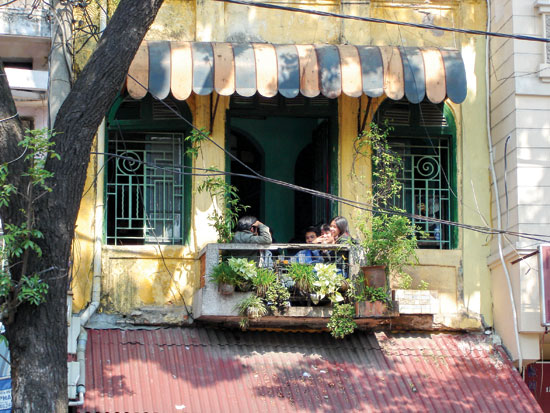(No.4, Vol.6,June-July 2016 Vietnam Heritage Magazine)

Photo: Tran Hau Yen The



In the times of kings, Vietnamese houses that looked out to the streets were not allowed to have views higher than the King’s
palanquin. So, upper storeys could not have windows, and certainly no balconies. A photograph of Hang Be Street taken in 1907 shows that even French-style houses dared not have a balcony jutting out.
Hanoi architecture quickly westernized after the planning of the French plenipotentiary. Since then, in Hanoi, many elegant and
sophisticated, Southern French-style houses appeared, that fit well with the natural surroundings. And almost all of them had balconies.
The ‘Western’ balcony gave the Viet people a new persona, that of city-dweller. Hanoi inhabitants now looked out over the land like lords.
Balconies are the most romantic architectural element in a house. It brings the moon and stars and outer space to the people inside.
The most popular balcony style was the jutting out-type, called Juliet’s Balcony after the world famous love story of Romeo and Juliet. Another kind, called yangtai, very popular in China, was also
prevalent. This balcony is above the porch, so one has to stick out one’s head in order to look to the sides.


A VIEW FIT FOR A KING
Traditional plastic art in Western balcony
Hanoi architecture under the French had three styles; ‘neo-classic’ (1900 – 1920, most notably, the Opera House), ‘Indo-Chinese’ (1925 – 1930, most notably the Indo-Chinese College), and ‘modern’ (after 1930, such as the Ministry of Science and Technology).
Each type of balcony has its own kind of handrail, distinct in shape and design, although each is made of the same four main
materials: ceramics, concrete, iron and wood. The banister design of each house reflects both its owner’s taste and social standing.
Almost all handrails have the house owner‘s name in capital letters cast or carved on the banister. Perhaps that was the house owner’s
delicate way to express his pride in the property
Another typical feature of old Hanoi handrails is the traditional designs, even when the owner was French. Typical designs are: clouds and waves, representing a prosperous life and good fortune, seal-type inscriptions such as ‘Happiness – Fortune – Longevity’ expressing major aspirations in life, an old coin with a square hole at the center and iron rope, intricately woven, a beautiful decoration representing family ties and unity.
There are also many Western designs, most notably the art
nouveau-influenced symmetric leaves and flowers design, much loved by the people of Hanoi. The delicate designs with soft curves, slender and voluptuous, twisting and bending, show the harmony between heat, hammer and the eyes of the creator. Villas on Hung Vuong, Dien Bien Phu, Ly Thuong Kiet, Hai Ba Trung, Tran Hung Dao streets are proof of how well Vietnamese blacksmiths have mastered new techniques and aesthetics.
Balconies in literature and art
Vu Trong Phung, born and raised in Hanoi, was one of the most famous Vietnamese writers in the 1930s. In his novel ‘A Mythomaniac’ written in 1932, he described a ‘very beautiful and very pretty’ house on Hang Co (Tran Hung Dao today) street as follows: ‘At dusk, we go out to the balcony to enjoy the evening cool. Lush green trees lining the street and luxuriant grass on the sidewalks make it feel like Eden on earth.’
Once, standing on a breezy balcony, the marvelous writer Nguyen Tuan, getting a glimpse of a person carrying green rice flakes, got the idea for the most fantastic piece about the green rice flakes. The balconies are one of those heartwarming treats of Hanoi, just as much as those green flakes.
Artist Nguyen Trung Tin, who lived all his life in Hanoi, had a series of balcony paintings, most notably the ‘Balcony’ and ‘Balcony and lotus’ pieces. The balconies in Nguyen Trung Tin’s art reflect the evolution of Vietnamese vision and values.
Among the photos of early XX century, a keen eye would see that the best ones were taken from a balcony. The height and open space gives the photographer a view which is both panoramic and intimate, where heaving tile roofs come alive like the people living under them.
A long time ago, whenever I looked up, I used to see somebody standing on a balcony gazing at the street life. What a nostalgic feeling. Today, most of the balconies are obscured behind electric lines and ad signs. Many have been transformed into bathrooms, kitchens and even toilets.

